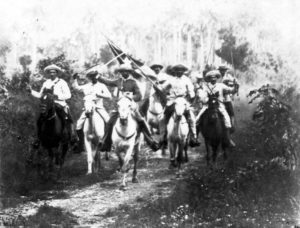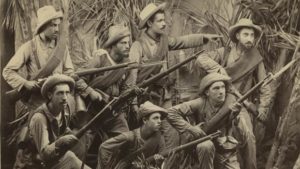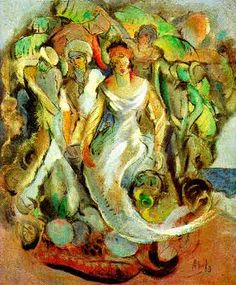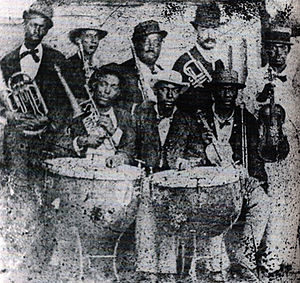 FRASES POPULARES CUBANAS: “ACABÓ COMO LA FIESTA DEL GUATAO”..
FRASES POPULARES CUBANAS: “ACABÓ COMO LA FIESTA DEL GUATAO”..
Durante muchos años todos los cubanos han oído repetir una frase que el uso ha hecho célebre: “Acabó como la fiesta del Guatao”. Lo curioso del caso es que desconocemos realmente qué fiesta fue aquella, aunque por el sentido que se da a la expresión se sabe que no tuvo un final feliz. Cuando aquí se dice que un suceso terminó de esa manera, nadie duda de que se trató de algo que empezó bien y finalizó mal.
El poblado del Guatao se fundó en 1750 en las tierras que cedió gratuitamente Esteban Godina a la vera del camino real que iba de La Habana a Vuelta Abajo. En 1827, por ejemplo, existían allí un almacén de víveres, dos tiendas de ropa, ocho tiendas mixtas, dos herrerías, una carpintería, una sastrería, una panadería, tres tabaquerías y una barbería. En 1959 no quedaban más que dos bodegas y una cantina, precarias las tres, y una fábrica de almidón era la única industria del poblado. La iglesia, que se edificó en 1765, se derrumbó en 1955. Entonces lo único que quedaba del Guatao era su fama: aquella de la fiesta.
¿Fue bronca de jaladera en medio de una celebración religiosa afrocubana? ¿La motivaron los celos y la furia de un marido burlado o la determinación de un grupo de hombres dispuestos a vengar una estafa? Se ignora qué pasó y hay quien asegura que no hubo tal fiesta en Guatao y sí una matanza horrible que en 1896 perpetraron soldados y voluntarios españoles entre la población indefensa y levantisca porque en Guatao, se afirma, hasta las piedras eran insurrectas.
El 22 de febrero de ese año los españoles cometieron en Guatao una matanzas de pueblerinos que se describe asi: Una columna compuesta por unos 200 guardias civiles, voluntarios y soldados salió de Marianao para operar en las zonas vecinas, y en Punta Brava se enfrentó con una partida insurrecta a la que no pudo aniquilar.
Entonces la columna vino hasta el Guatao, cogió a todo el que pudo y lo metió en la iglesia. De allí los sacaban amarrados y los mataban en el suelo… De noche partió la columna llevando unos 20 prisioneros de los cuales solo cinco llegaron a Marianao. En la carretera quedaron 16 cadáveres. Se dice que unos 50 muertos causó aquella tragedia.
Y ASÍ ACABÓ LA FIESTA…
Unos meses despues en Guatao se celebraba un baile para festejar el fin de la guerra contra España y a la celebración concurrieron, de guilletén, muchos voluntarios y elementos proespañoles hasta la víspera para ver qué acogida se les daba.
Cuenta la historia que tambien por aquellos días, Ángel Bildosa y Merced Amador, dos vecinos del poblado, mantenían relaciones amorosas, pese a que Ángel era casado. Llegó la fecha del baile y Ángel, prohibió a su amante que acudiese a la fiesta. Parece que sospechó que ella no lo obedecería y ya a medianoche se fue a casa de la querida. No la encontró y decidió buscarla donde sabía que estaba. Cuando entró a la fiesta, Ángel vio que Merced bailaba con el teniente Abad, de los voluntarios españoles.
No se molestó en pedir explicaciones. Rasgó el vestido de la mujer de arriba abajo, y ella, que también se las traía, se descalzó y a taconazo limpio la emprendió contra su compañero. Quiso intervenir a favor de Merced el exteniente Abad y ahí se armó la gorda porque los vecinos, que se las tenían juradas a voluntarios y guerrilleros españoles desde la matanza de 1896, aprovecharon la oportunidad para cobrárselas. La leña estuvo sata y los enemigos de ayer quedaron mal parados.
Para algunos autores esa matanza fue la que dio origen a la frase. Pero ¿quién sabe? Porque de aquel pasado sangriento, pendenciero y bullente del pueblo, no queda más que una frase: “Acabó como la fiesta del Guatao”…
 POPULAR CUBAN PHRASES: “IT ENDED LIKE THE PARTY OF GUATAO” ..
POPULAR CUBAN PHRASES: “IT ENDED LIKE THE PARTY OF GUATAO” ..
For many years, all Cubans have heard a phrase that the use has made famous: “It ended like the party of Guatao”. The curious thing is that we do not really know what party was that, although the meaning given to the expression is known to not have a happy ending. When here it is said that an event ended that way, no one doubts that it was something that started well and ended badly.
Guatao was founded in 1750 in the lands that Esteban Godina yielded free of charge to the side of the royal road that went from Havana to Vuelta Abajo. In 1827, for example, there was a grocery store, two clothing stores, eight mixed shops, two ironworks, a carpentry shop, a tailor shop, a bakery, three tobacco shops, and a barber shop. In 1959 there were only two wineries and one canteen, all three of them precarious, and a starch factory was the only industry in the town. The church, which was built in 1765, collapsed in 1955. Then the only thing that remained of the Guatao was its fame: that of the fiesta.
Was it jaladera anger in the middle of an Afro-Cuban religious celebration? Was it motivated by the jealousy and fury of a mocked husband or the determination of a group of men willing to avenge a scam? It is unknown what happened and there are those who say that there was no such party in Guatao and a horrible massacre that in 1896 perpetrated Spanish soldiers and volunteers among the defenseless and levantisca population because in Guatao, it is claimed, even the stones were insurgent.
On February 22 of that year the Spaniards committed in Guatao a massacre of villagers that is described as follows: A column composed of about 200 civil guards, volunteers and soldiers left Marianao to operate in the neighboring areas, and in Punta Brava was confronted with an insurrectionary party that he could not annihilate.
Then the column came to the Guatao, took all who could and put it in the church. From there they were tied up and killed on the ground … At night the column left with about 20 prisoners, of whom only five arrived in Marianao. On the road were 16 bodies. It is said that about 50 dead caused that tragedy.
AND THAT’S HOW THE PARTY FINISHED …
A few months later in Guatao a dance was celebrated to celebrate the end of the war against Spain and the celebration attended, from guilletén, many volunteers and pro-Spanish elements until the eve to see what reception was given.
In those days, Angel Bildosa and Merced Amador, two neighbors of the town, maintained romantic relationships, even though Angel was married. The date of the dance arrived and Ángel, prohibited his lover from attending the party. It seems that she suspected that she would not obey him and already at midnight she went to the mistress’s house. He did not find her and decided to look for her where he knew he was. When he entered the party, Angel saw that Merced was dancing with Lieutenant Abbot, of the Spanish volunteers.
He did not bother asking for explanations. He tore the woman’s dress up and down, and she, who was also bringing them, took off her shoes and with a clean heel kicked against her partner. He wanted to intervene in favor of Merced, the ex-Abad, and that was the reason why the neighbors, who had sworn them to volunteers and Spanish guerrillas since the massacre of 1896, took the opportunity to collect them. The firewood was sata and the enemies of yesterday were badly stopped.
For some authors that slaughter was the one that gave rise to the phrase. But who knows? Because of that bloody, quarrelsome and boisterous past of the people, there is only one sentence left: “It ended up like the party of Guatao” …
Agencies/ Ciro Bianchi/ Extractos/ Excerpts/ Internet Photos/ Arnoldo Varona/ www.TheCubanHistory.com
THE CUBAN HISTORY, HOLLYWOOD.



 < POPULAR CUBAN PHRASES: "Acabó como la Fiesta del Guatáo"..
< POPULAR CUBAN PHRASES: "Acabó como la Fiesta del Guatáo"..





